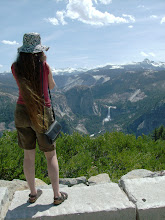This is a frequently asked question - what are the options for fresh air ventilation for Energy Star, Healthy Built, and LEED, and what are the pros and cons of each?
There are basically three options for fresh air ventilation - I'll offer a short description of each below and try to summarize the pros and cons that I hear most frequently discussed. While I would love to see everyone install an ERV, it isn't always feasible.
1) ERV (Energy Recovery Ventilator): This is a device that has its own fan that brings in fresh outside air and exhausts some air from the home. It can be tied into the home's HVAC ductwork, but it doesn't have to be - it can be separately ducted as well.
PROS:
Pressure-balanced system. This is mainly a concern for super-tight homes.
You know where the air is coming from (because you choose the location of the outside air intake).
Energy recovery recaptures some energy from the outgoing air.
The ERV fan has a smaller fan than the air handler (usually about 100W, but some new models are as low as 40 W).
Can work with non-ducted systems (like radiant floor).
Versions available with high-efficiency filters.
CONS:
Most expensive option - probably $1500-$2000 installed.
Some less expensive versions don't have timers or speed controls and may give you more air than you want.
2) Supply air only - This system involves a small outside air intake duct that connects to the return side of the air handling unit for the home. To qualify as a ventilation system, there MUST be an automatic damper in the duct and a controller. The controller is set to operate for a specified number of minutes each hour, and will cycle the air handler fan if it does not run for this period of time in any given hour. If the fan runs longer, the damper will close to avoid over-ventilation. The "air cycler" and a similar controller by Honeywell are the most commonly installed local versions of this system.
PROS:
You know where the air is coming from (because you choose the location of the outside air intake).
Intake air passes through the filter in the air handling unit, which could be high-efficiency. It's also a good idea to have a coarse filter right at the intake duct.
Since it uses the air handling fan, this also mixes air in the home to dilute pollutants. This can reduce occupant exposure to some types of pollutants (those emitted in occupied rooms).
Less expensive to install (~$300-400 typically).
Puts house under positive pressure. Some people feel that this is better than negative pressure, but the pressure is fairly small, and it's not clear to me that this is the biggest issue at play in our location.
CONS:
No energy is recovered from the outside air.
The air handling fan uses a lot of power (~300-400W), so it doesn't need to cycle for much extra time before a lot of energy is used. There is little additional cycling in many climates but because Asheville has extended periods of mild weather, there could be a lot of fan cycling here. This system uses the most overall energy of the three options.
Cannot be easily be used with non-ducted HVAC systems.
3) Exhaust only - This system involves using an exhaust fan that either runs continuously or on a timer to exhaust air from the home. There are bath fans available that do "double duty" as this type of fan (they run on a low, continuous setting all the time and then kick up to the normal flow rate when it's used as a bath fan). The fans have to be low sone. The Panasonic Whisper Green is often used locally; Broan/Nutone also has models that allow numerous fans to be controlled together to perform this function. There is also a switch called the "Smart exhaust" that will convert any low-sone bath fan to this function.
PROS:
Can be used with non-ducted systems.
Very low installation cost. Bath fans with this capability run approximately $150, and the smart exhaust switch is available locally for about $50.
Overall operating cost in our climate is relatively low. Although there is no heat recovery, the fan wattage is typically very low (10-20 Watts), so the overall energy consumption is almost as good as most ERVs.
Usually involves a bath fan upgrade, which increases the likelihood that the bath fan will function well as a bath fan and remove moisture from the home. Can be very helpful in densely occupied homes to keep indoor humidity levels down.
CONS:
Incoming air is not filtered.
Puts house under negative pressure. Some people don't want to do this, but the pressure is fairly small, and this is probably most important if you know the home has a problem crawlspace, etc. There are limits to how much air you can move at a time with this system in hot/humid climates, but it's usually possible to comply. Asheville is not considered a hot/humid climate. (it's mixed/humid)
No energy is recovered from the outside air.
You can't control where the air is coming from, so it is important to seal the house well from garages, crawlspaces, etc. A house with a lot of surface area that is attached to something like a problem crawlspace might not be a good candidate for this system.
The system does not mix the indoor air.
Wednesday, March 10, 2010
Subscribe to:
Posts (Atom)
